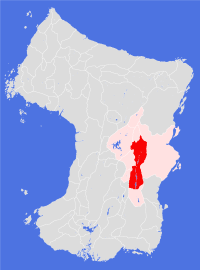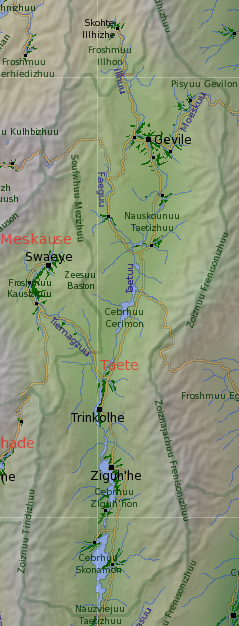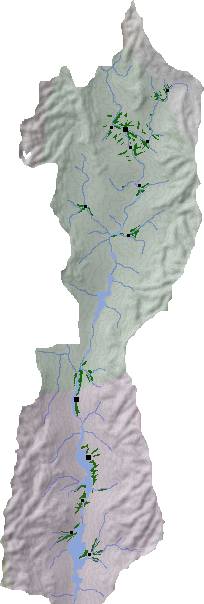Taete

Societal ties: Balhe
Current population: 1
Main language(s): Gevey
Area: 462,000km²
Natural and political borders
Encompassing a good proportion of the Taete valley, the Land stretches almost 1,400km between its northern and southern borders, and for much of that length it is bounded by eastern and western mountain chains, including: Soufwhuu Mezizhuu, Zeesuu Baston, Zoiznuu Tindizhuu, Zoiznuu Kavadhizhuu, Zoiznuu Frenisonizhuu and Zoiznajarhuu Frenisonizhuu.
Both political borders lie on the Taete river, the southern border at latitude 7.8°N and the northern one at latitude 20.0°N - though Taete has never formally recognised the existence of Illhe as a Land.
History
The people of Taete consider their Land to be the heart of Balhe Society, and the river that runs the length of the Land to be its soul. It is possibly because of this belief that most of the strife that has occurred during the history of the Balhe Society has taken place within this Land's borders.
The initial colonisation of Taete was a fairly orderly affair, proceeding northwards over the course of 60 orbits (roughly two generations) as the Balhe population expanded rapidly. The southernmost settlements were established in the early gt700s, Ziguh'he in gt708, Trinkolhe in gt725. Settlements around Cebrhuu Cerimon became viable in the early gt740s; Gevile followed in gt760. By gt790 pioneers from Gevile were moving east through the Pisyuu Gevilon to colonise the Cantan Plains. The eighth century is considered by many people nowadays to be a golden age, a time of adventure and expansion.
The eighth century is not only remembered as a time of agricultural expansion: it is during this period that much of the knowledge that was apparently lost during the Vreski Time of Strife in the gt670s was regained and improved upon. The cities that were founded during this time were places of industry and learning. Although each settlement and city was effectively independent, and the transportation of goods along the river was difficult, the movement of people and ideas between settlements was encouraged.
One of the ideas that travelled during this time was the Jaesconesh belief in the vengeful creator. Balhe Society during the eighth century had a high tolerance for differing personal beliefs and theological dispute was often viewed as a public entertainment. The original vehemence of the Seer Ganuete's beliefs had been toned down by subsequent leaders, and Jaesconesh was seen as one of many competing belief systems - albeit that the sect was more organised and centralised than most others.
Many historians have attempted to explain what happened to change the situation as it stood at the end of the eighth century and the outbreak of the Taete wars in gt849. One of the most popular theories dates the change to the rise of the self-sufficiency creed in the early 820s, most vocally promoted by Zekhen'haale and her supporters - originally from the Cebrhuu Cerimon - around this time. Certainly by the late gt830s, Jaesconesh families were living apart from the rest of the communities in most settlements in the valley, with Jaesconesh quarters established in all of the cities.
By the mid gt840s, the Jaesconesh preference for helping their own before helping others, and in some places their refusal to take part in communal activities unless the community agreed to various terms and conditions, was beginning to produce a political polarisation in settlements across the valley. While some people, and some local governments, were willing to accede to Jaesconesh demands "for the good of the community", others were not. The fact that some more extreme Jaesconesh demands were being met in some places led to ever-more extreme demands during the second half of the gt840s.
By the start of the ninth century Gevile had become the leading, and most populous, city in the valley, partly because of its position as the gateway to the east and partly due to the favourable cultivation conditions in that part of the valley. It was in this city that the idea of an independent Jaesconesh state, obedient to the rules and beliefs of the sect, was first raised and debated. By the late gt840s over 30 per cent of the city's population was Jaesconesh, where they had effectively formed a city within a city. Cultivations surrounding the city were divided into Jaesconesh and non-Jaesconesh; Jaesconesh businesses were allowed to discriminate against non-believers; there was even a separate legal and educational system for sect members.
In gt849 the Jaesconesh gained sufficient political control of the city to pass ordinances banning non-Jaesconesh religious practices. During the late autumn of that orbit riots broke out against the new ordinances; these were harshly repressed, with over 500 deaths - popularly known today as the Gevile massacre. By the beginning of gt850 the Jaesconesh had tightened their control on the city and refugees were fleeing in large numbers to surrounding settlements
The Taete wars - fought between believer and non-believer militias that first formed in gt850 - raged for more than 6 orbits. Cities and plantations across the Land were occupied, militarised and fought over by both sides during the course of the wars, and the scars of that conflict remain to this day. The early battles were local and often uncoordinated; however, after the Cebrhuu Cerimon soil poisonings in the spring of gt854 the non-believer militias coalesced into a single army with widespread support both within the valley and beyond.
The soil poisonings are perhaps the most shocking aspect of this civil war. In all Societies, across the planet, the cultivated soil is considered to be sacrosanct: to deliberately poison a cultivation is a crime not just against humanity, but against life itself. Throughout the often contentious colonisation of the continent, only in this conflict were cultivations deliberately poisoned. The question of who first poisoned the Cebrhuu Cerimon cultivations remains hotly disputed, with both sides blaming the other. The propaganda war, on the other hand, was decisively won by the non-believers, and it was the call to punish the Jaesconesh soil poisoners that finally united the non-believer militias and bought considerable support and resources from the eastern cities and settlements.
By the spring of gt856 the war was over, with Jaesconesh militias and survivors contained within the city of Gevile. Peace negotiations between the two sides were brief and to the point: the Jaesconesh were told to leave the valley, or die. In the event more than ten thousand believers chose exile, embarking westwards on a long trek into the western mountains that they came to call the Journey of Terror. The few thousand believers that chose to remain in the city were effectively ostracised by the rest of Balhe Society - almost all of them chose to follow their fellow believers across the mountains during the next 20 orbits.
The civil war left the valley economically shattered, but socially and politically cohesive. In gt879 the settlements and cities in the valley agreed to unite together, creating the Land of Taete. Under this agreement, trading laws were regularised and a set of basic civil and criminal laws were agreed. Each settlement and city was required to maintain a civil guard, which in turn contributed resources and people to a national guard to protect trade routes and the Land's borders. A political system was established which kept most power (and all taxes) at the local level, but also allowed for a Land Mayor to be elected to oversee the running of the new structures and to settle disputes between settlements. Each city, and some of the settlements, continued to mint their own currencies though a system of permits issued by the Land Mayor.
For the most part the Land system has worked well for the people of the valley, giving them a relatively stable economy and increasing prosperity for more than 300 orbits. The biggest test the Land has had to face has in fact been religious. The gt1020s saw the rise of another charismatic fundamentalist - Mi'huede - who began his preaching in Zeluerhine and moved slowly northwards. While nowhere near as successful as the Jaesconesh, his vision of the wrathful god attracted a following of several thousand by the time he reached the walls of Gevile in gt1026. Denied entry to that city, and threatened with slaughter, he continued northwards and founded a new settlement in the Froshmuu Illhon.

Politics and economy
Taete is effectively a federal democracy, with settlements and cities having substantial autonomy from the federal core. The Land Mayor is directly elected every 6 orbits and is responsible for maintaining the transport infrastructure, overseeing the operation of inter-settlement trade and negotiating improvements to the basic trade, civil and criminal laws. The Land Mayor is also responsible for maintaining a stable economy and has the power to control local currency production.
The Taete economy is diverse, including agriculture, light and heavy industrial production, with healthy and competitive service and retail sectors. Trade guilds were initially set up to regulate local economic activity, though no guild was permitted to dominate any single economic sector nationally. Modern guilds tend to operate like co-operatives; restrictions on which sectors a particular guild may operate in were abolished two centuries ago. The one area where trade guilds do not dominate is in retail, where instead family businesses are the norm.
Culture and other issues of interest
Guilds play an important role in Taete society, providing education, employment and personal development for their members. To become a member of a guild, a person will need to invest in the guild - normally this means a family paying a guild to educate their children, who then become guild members when they come of age. Some guilds are highly geographical in nature, and can be thought of as neighbourhoods rather than trade associations; other guilds prefer to specialise in a particular trade, such as the Trinkolhe Communications Guild - which has played a leading role in the spread of various electronic communications networks over the past century. Yet other guilds operate on a more social basis: the Mothers and Orphans Guild in Gevile is responsible for providing a number of vital social services across the city, and is subsidised by a direct tax on all individuals within the city.
Given the role that religion has played in the history of Taete, it is perhaps surprising that temples also play an important part in the culture of the Land. The official religion of the Land is the worship of Jaakra - the creator - and every settlement and neighbourhood is required by law to maintain a temple for the spiritual care of the community. In practical terms, the temples operate as a social centre for the neighbourhood separate from guild interference, and can be viewed as a cross between a local museum/archive, a local school and a health clinic - most health workers are trained in the City Temples.
Key natural features
The Taete valley, including Nauzviejuu Taetizhuu and Nauskounuu Taetizhuu, is a wide, straight and generally gently sloping valley surrounded by tall mountains on its eastern and western flanks. The Taete river flows southwards through the valley via a series of long lakes, including Cebrhuu Gerimon, Cebrhuu Ziguh'hon and Cebrhuu Skonamon - the three largest lakes in the Land. The western mountains include Mts. Kulhbon (5,420m), Baston (3,350m), Tibolestuu (3,900m) and Yenuu (5,260m); the eastern mountains include Mts. Zhawhaenuu (4,430m), Cibiluu (2,790m), Shtalhaghuu (4,410m), Dhaneluu (4,130m), Lerhestuu (3,530m), Kaloofuu (4,570m), Frenisonuu (5,130m) and Olharhuu (3,710m).

Habitats
The northern half of Taete belongs to the high valleys habitat, while the southern half falls within the warmer eastern valleys habitat. One settlement, in the far north east of the Land, is at the western extremity of the eastern interior habitat
Plantations and settlements
The colonisation of the Taete valley followed the pattern of establishing widely dispersed cultivations across the valley capable of supporting just the one settlement. Some of these cultivations grew faster than others, for instance the southern city-plantations of Ziguh'he and Trinkolhe. In the north, conditions were tougher - here the main cultivation was at Gevile; as the population of that city grew, satellite settlements were established around it. Over time, these cultivations merged to form the Gevile Plantation.
In addition to the three cities, there are ten other settlements: three around Gevile; one (the newest settlement) in the Pisyuu Gevilon; two on the southern part of Nauskounuu Taetizhuu; one in the Faeguu valley; one at the southern end of Cebrhuu Ziguh'hon; and two (the oldest settlements) on the shores of Cebrhuu Skonamon.
Cebrhuu Cerimon was once host to four separate settlements around its shoreline - these cultivations were all destroyed during the course of the Taete wars. The settlements have been deliberately left as ruins as a memorial to all those who perished in the conflict.
Key towns and cities
Rural population: 0 (0.0% of total)